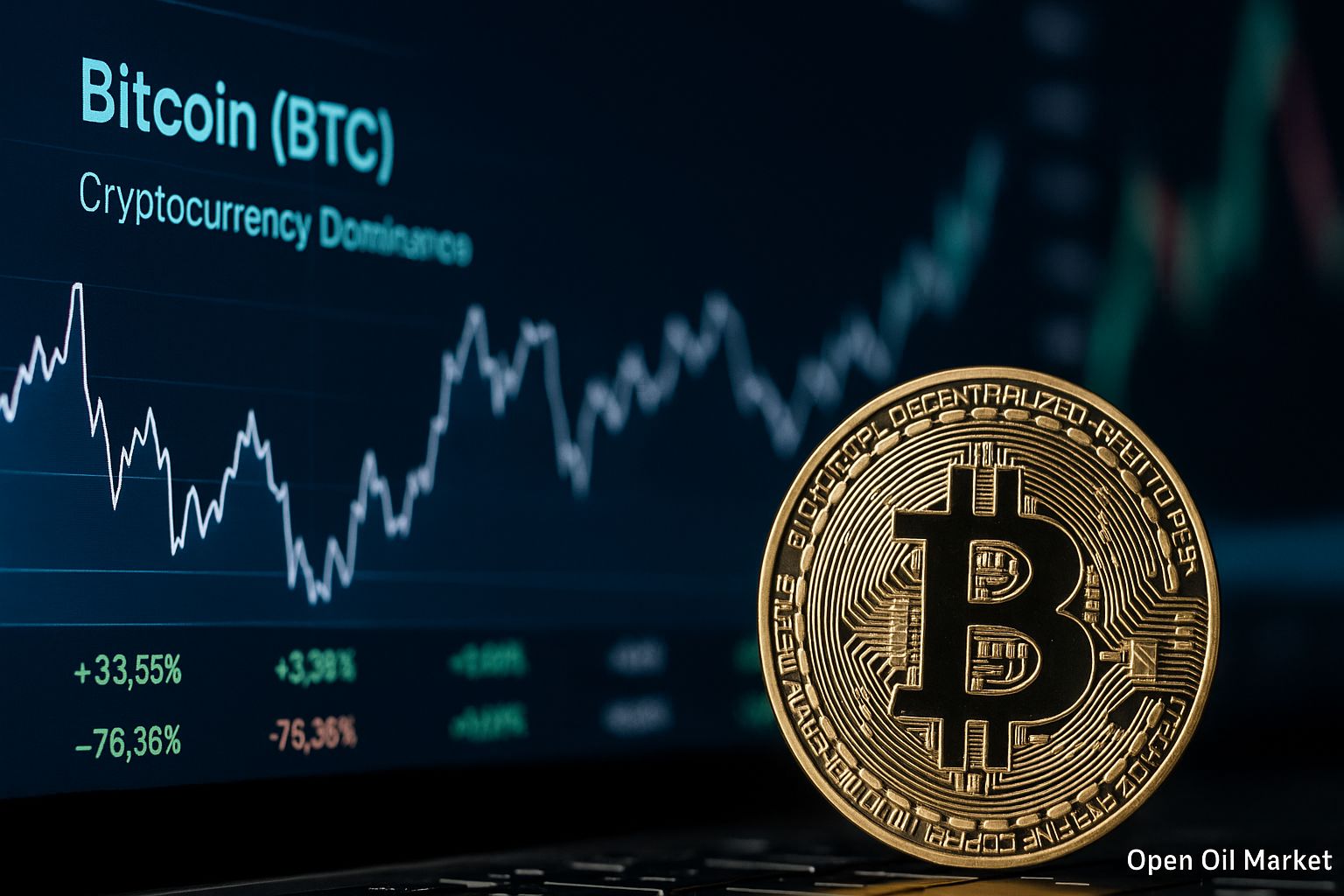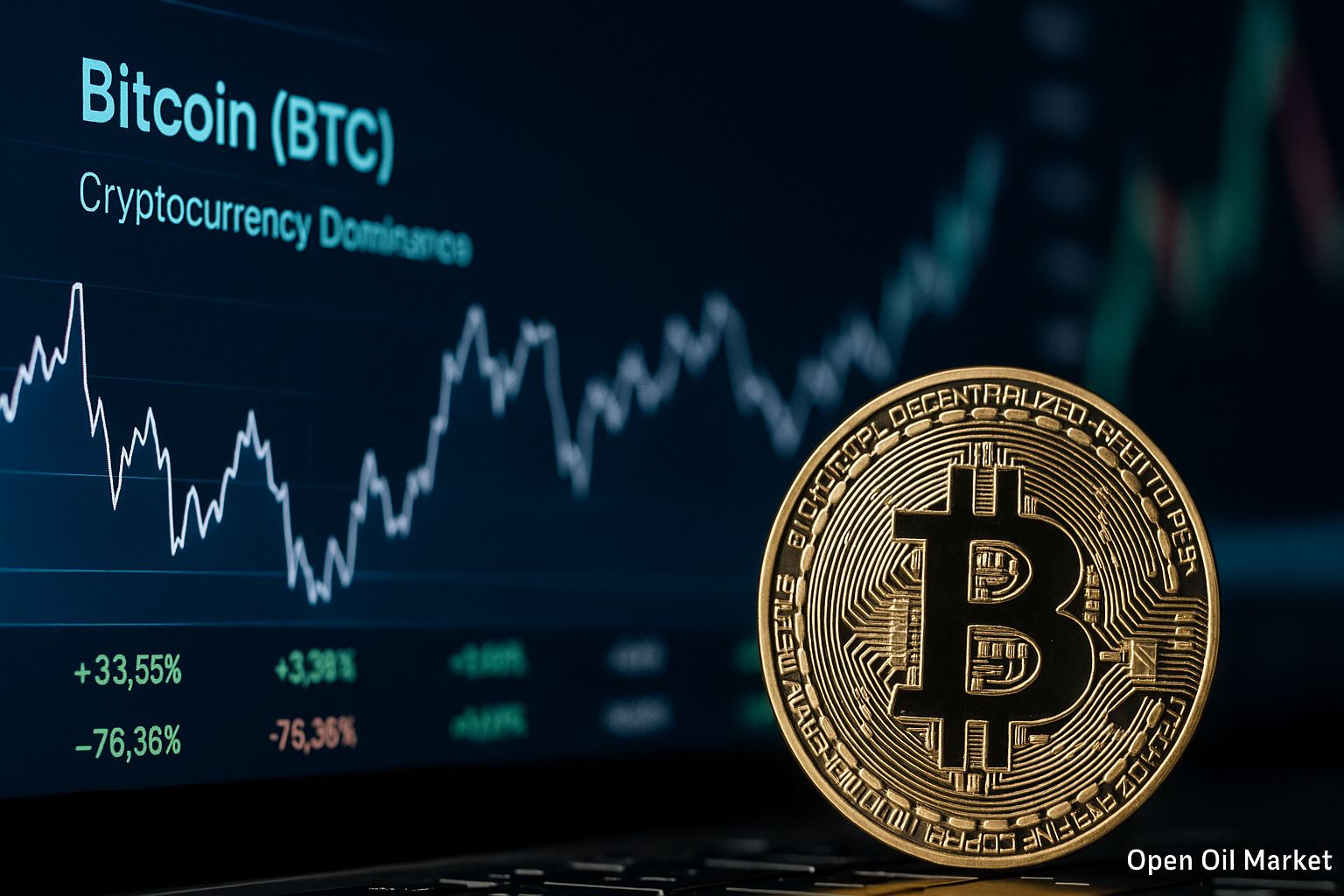
Current Cryptocurrency News as of November 13, 2025: Bitcoin Maintains Level Above $100,000, First XRP ETF Launches in the U.S., Traditional Banks Integrate Cryptocurrencies, Institutional Investors Remain Confident, Overview of the Top 10 Popular Cryptocurrencies.
Bitcoin Holds Above $100,000 Amid Macro Optimism
After a rapid rise in recent months, the flagship cryptocurrency Bitcoin (BTC) is maintaining six-figure levels. As of the morning of November 13, BTC is trading around $105,000, having retreated from the August peak (~$124,000), but still significantly higher than the levels at the beginning of the year. Bitcoin's market capitalization stands at approximately $2.1 trillion (about 58% of the total cryptocurrency market capitalization), reaffirming its dominant role. Investors note that the resolution of the protracted U.S. government shutdown added confidence to the markets: the Senate approved a budget agreement, ending a 41-day government deadlock and lifting uncertainty. The initiative surrounding "tariff dividends" — proposed by President Donald Trump to allocate revenue from import duties for one-time payments to citizens ($2,000 each) — further fueled positive sentiment. These measures strengthened expectations that increased liquidity and economic stabilization will support demand for risk assets, including Bitcoin.
Analysts point out that Bitcoin now has a path towards renewing its highs if it can confidently overcome the nearest significant resistance around ~$110,000. Overall, sentiment surrounding Bitcoin remains predominantly optimistic. Many investors view BTC as "digital gold" and a hedge against inflationary risks, especially in light of potential easing of monetary policy by leading central banks.
Ethereum and Major Altcoins: Consolidation Following Growth
The second-largest crypto asset, Ethereum (ETH), is showing stability after a summer rally. The price of ETH is around $3,550, which is below its historical high ($4,890 in 2021), but confirms its strong market position. Ethereum still constitutes ~12% of the total market capitalization (~$420 billion) and remains the foundational platform for smart contracts, decentralized finance (DeFi), and numerous blockchain applications. Institutional interest in ETH is sustained by ecosystem development and demand from major players: newly launched spot ETFs in the U.S. on Ethereum have simplified accessibility for investors. Although Ethereum funds have seen outflows in recent weeks as some investors took profits after price increases, the long-term sentiment surrounding Ethereum remains positive.
Many other leading altcoins, after a vigorous rise in early autumn, have shifted into a consolidation phase. Investors are reassessing risks and partially taking profits, resulting in a mixed performance of major coins. Nevertheless, individual projects are showing resilience and even growth due to their own news drivers. For instance, the token of the decentralized exchange Uniswap (UNI) surged by over 20% this week after the team proposed introducing a fee (which would make the token deflationary), although it subsequently retreated from its local peak. Overall, the altcoin market remains volatile: many coins fluctuate in the range of 5-10% over the week, reacting to technological updates, new partnerships, and regulatory decisions.
Traditional Finance Embraces Cryptocurrencies
The crypto industry is gaining increasing support from traditional financial institutions. This week marked a significant event: the American bank SoFi announced the launch of cryptocurrency trading services for its customers. SoFi became the first bank in the U.S. to directly offer the buying, selling, and storage of digital assets, including Bitcoin, Ethereum, and Solana. The bank's management noted that this decision was made possible by clarified regulatory guidelines — as recently as spring 2025, the Office of the Comptroller of the Currency (OCC) officially allowed federally chartered banks to provide crypto services. Following these clarifications and growing client demand, several major banks have begun exploring opportunities for working with digital assets. The launch of crypto services by SoFi is an important step towards integration: retail investors can now access the crypto market through familiar banking applications, significantly expanding the market audience.
Moreover, SoFi announced plans to issue its own stablecoin (a digital dollar pegged to USD) and integrate blockchain technologies into its lending and payment products. Experts expect that SoFi's example will encourage other banks to enter the cryptocurrency market. Simultaneously, traditional investment firms continue to launch new products: exchange-traded funds (ETFs) and trusts focused on crypto assets — from Bitcoin and Ethereum to entire baskets of altcoins — are emerging in various countries. This surge in activity from financial organizations indicates that cryptocurrencies are increasingly recognized as a legitimate asset class that traditional banks and funds are ready to engage with.
Regulation: Legislative Initiatives Following the Shutdown
The regulatory environment surrounding cryptocurrencies continues to improve, gradually removing previous barriers. The resolution of the budget crisis in the U.S. positively affected not only investor sentiment but also unblocked legislators. A new comprehensive bill regulating digital assets is progressing in Congress. This week, the Senate Agriculture Committee presented the Crypto Market Structure Bill, proposing to establish clear rules for the industry. The bill provides for delineation of authorities among regulatory bodies: the Commodity Futures Trading Commission (CFTC) is expected to take control over crypto exchanges and derivatives, while the Securities and Exchange Commission (SEC) will focus on tokens that may be classified as securities. The goal of this initiative is to ensure market transparency and investor protection without stifling innovation.
The U.S. administration is also demonstrating support for the fintech sector: preparations are underway for a so-called New Structure Bill aimed at modernizing the financial system, where the crypto industry could play a significant role. Similar trends of integrating cryptocurrencies into the legal framework are observed in other countries. For example, Brazil's Central Bank recently extended anti-money laundering (AML) and counter-financing of terrorism requirements to cryptocurrency companies and services. In the European Union, unified MiCA regulations are being implemented, and their phased rollout in 2024-2025 is already stimulating activity among licensed crypto exchanges in Europe. Overall, regulators worldwide are rapidly developing rules for digital assets — this reduces market uncertainty and attracts more conservative participants.
Institutional Investors and Capital Movement
Large investors continue to show interest in cryptocurrencies, although mixed trends in capital flows are observed in the short term. Following record inflows during the summer, there has been a correction in the autumn: over the past two weeks, digital investment products have recorded a total outflow of around $1.1 billion, primarily from Bitcoin and Ethereum funds, as some investors decided to take profits after price increases. According to CoinShares, only in the past week, about $900 million was withdrawn from Bitcoin-focused funds and about $400 million from Ethereum funds. However, not all segments are showing outflows: on the contrary, XRP funds attracted approximately $28 million during the same week, indicating a reallocation of interest towards alternative assets with practical value.
Overall, the total capitalization of the cryptocurrency market remains around $3.6 trillion, approximately 5% above the lows experienced in early November, signaling a gradual return of buyers. Institutional players are actively using market dips to enhance their positions. Analysts report that large holders ("whales") recently purchased about $200 million worth of Cardano (ADA) tokens during price decreases — reflecting confidence in the long-term prospects of the project, despite delays in launching an ADA ETF. Fund inflows continue even into already launched exchange-traded funds: following a pause at the beginning of the month, spot Bitcoin ETFs in the U.S. are again recording a small net inflow (~$1.2 million over the past 24 hours as of November 12), indicating stabilization of sentiment.
Institutional interest is also extending to other assets. Today marks the launch of the first spot ETF on XRP in the U.S. (managed by Canary), and heightened demand for this instrument is expected — the total volume of assets under management for such XRP ETFs may exceed $800 million in the initial days. Moreover, new exchange-traded funds targeting Solana have emerged in the U.S. market, also beginning to attract capital. The activity of such products, alongside the involvement of public companies (e.g., MicroStrategy regularly increasing its BTC reserves), confirms that the institutional segment is firmly established within the crypto sphere and continues to expand.
Market Sentiment and Forecasts
The mood in the cryptocurrency market by mid-November can be characterized as cautiously optimistic. The "fear and greed" index for Bitcoin and major altcoins has risen from the fear zone into moderate greed territory, reflecting a predominance of cautious optimism without signs of extreme euphoria. Market participants are encouraged by a combination of favorable factors — from signals of monetary policy easing to positive news about regulation and integration of cryptocurrencies into the traditional financial sector. At the same time, experts warn of risks of short-term volatility: the rapid price increases in recent weeks have been accompanied by spikes in liquidations in the derivatives markets, reminding stakeholders of the fragility of the current balance.
Investors will continue to closely monitor regulatory actions and key macroeconomic indicators (such as inflation data and interest rates). The future trajectory of the ongoing recovery largely depends on these factors, and whether the current recovery will evolve into a sustained market growth phase by the year's end. Many analysts are optimistic and consider the possibility of Bitcoin reaching new historical highs in the coming months if current trends continue, although the consensus suggests that the upward path will be accompanied by increased volatility.
Top 10 Most Popular Cryptocurrencies
As of the morning of November 13, 2025, the following digital assets are among the top ten largest and most popular cryptocurrencies by market capitalization:
- Bitcoin (BTC) — the first and largest cryptocurrency. BTC is currently trading around $105,000 after a correction from August's peak; its market capitalization is approximately $2.1 trillion (≈58% of the total market).
- Ethereum (ETH) — the second largest cryptocurrency and leading platform for smart contracts. The price of ETH is approximately $3,550, which is significantly above last year’s levels; market capitalization is around $420 billion (≈12% of the market).
- Tether (USDT) — the largest stablecoin pegged to the U.S. dollar at a 1:1 ratio. USDT is widely used for trading and transactions; its market capitalization is around $150 billion, and price remains consistently around $1.00.
- Binance Coin (BNB) — the native coin of the largest cryptocurrency exchange Binance and the base token of the BNB Chain. BNB is valued around $950, close to its historical peak; market capitalization is approximately $140 billion. Despite legal pressure on Binance, the token remains among the leaders due to active usage on the platform and in DeFi.
- Ripple (XRP) — the token of the Ripple payment network for cross-border payments. XRP trades around $2.50; its market capitalization is estimated at approximately $130 billion. Legal clarity regarding XRP's status in the U.S. (Ripple's victory in its dispute with the SEC) has strengthened investor confidence and allowed the token to maintain its position among major assets.
- Solana (SOL) — a high-performance blockchain platform for decentralized applications. SOL is holding around $160 per coin (with a market cap of ~$80 billion), having retreated from earlier peaks of $200 reached this year. Interest in Solana is supported by the growth of its ecosystem and the emergence of investment products (ETFs) focused on this asset.
- USD Coin (USDC) — the second-largest stablecoin backed by dollar reserves (issued by Circle). The price of USDC is strictly maintained at $1.00; its capitalization is around $60 billion. USDC is widely used by institutional investors and in DeFi due to its transparency and regular audits of reserves.
- Cardano (ADA) — a blockchain platform developed with a scientific approach to development. ADA is currently priced at approximately $0.70 (market cap ~$25 billion) after retracing from recent local peaks around $1.00. Cardano is drawing attention with plans to launch an ETF for this token and an active community believing in the project's long-term growth.
- TRON (TRX) — a platform for smart contracts and decentralized applications, especially popular in Asia. TRX trades around $0.30; its market value is ~ $28 billion. TRON maintains its place in the top 10 largely due to the usage of the network for stablecoin issuance (a significant portion of USDT circulates on the Tron blockchain) and its ongoing ecosystem development.
- Dogecoin (DOGE) — the most well-known meme cryptocurrency, initially created as a joke. DOGE is holding near $0.18 (market cap ~$30 billion), supported by a loyal community and periodic celebrity attention. Despite high volatility, Dogecoin continues to rank among the top ten coins, demonstrating remarkable resilience to investor interest.




